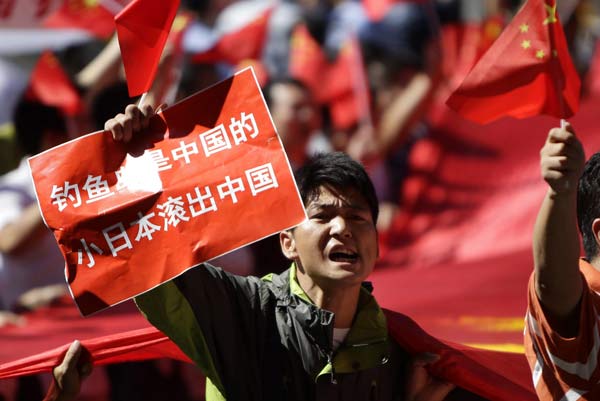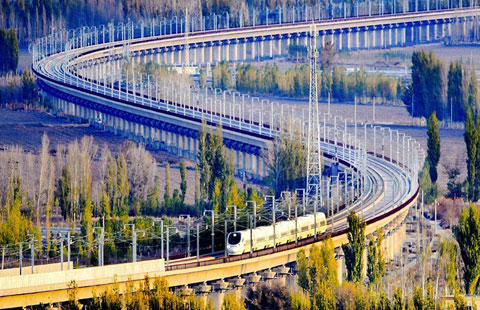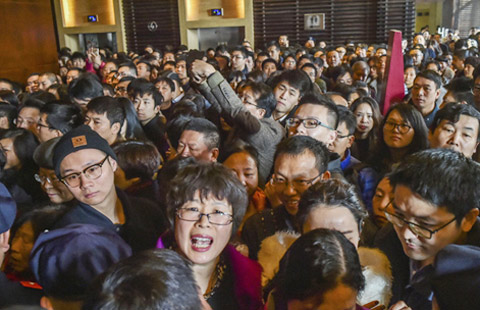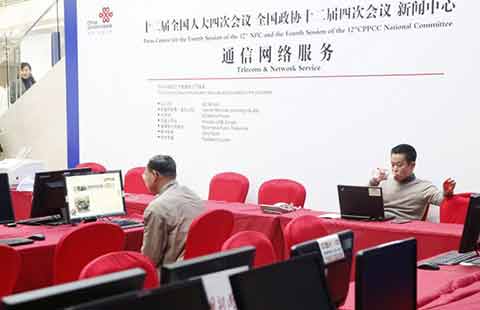

 |
|
A protester, taking part in a demonstration outside the Japanese embassy in Beijing on Thursday, displays a sign stating that "The Diaoyu Islands belong to China, Japan get out of China". Jason Lee / Reuters |
Editor's note: On Tuesday, the People's Daily ran an article explaining the historical background of the Diaoyu Islands. A translation of the article is printed below:
On September 10, 2012, the Japanese government announced its decision to "purchase" Diaoyu Island and its affiliated Nanxiao Island and Beixiao Island under what Tokyo called "nationalization". This move taken by the Japanese government constitutes a serious violation of Chinese territorial sovereignty. The Chinese government and people firmly oppose it and have strongly protested against the move.
1. Diaoyu Islands have been China's inherent territory since ancient times.
1) Diaoyu Islands were first discovered, named and exploited by the Chinese people.
Diaoyu Island and its affiliated islands, including Huangwei Islet, Chiwei Islet, Nanxiao Island and Beixiao Island (hereafter referred to as the Diaoyu Islands) have been an integral part of Chinese territory since ancient times. The book Voyage with a Tail Wind (Shun Feng Xiang Song), which appeared in 1403 (the first year of the reign of Emperor Yongle of the Ming Dynasty), recorded the names of islands that Chinese voyagers passed en route from Fujian to Ryukyu such as "Diaoyu Islet" and "Chikan Islet", known today as Diaoyu Island and Chiwei Islet.
The imperial courts of the Ming and Qing dynasties sent imperial title-conferring envoys to the Ryukyu Kingdom 24 times. Records of the Imperial Title-Conferring Envoys to Ryukyu (Shi Liu Qiu Lu), and voluminous materials left by the envoys, have depicted the topography and geography of the Diaoyu Islands in detail and recorded the demarcation line between China and Ryukyu east of Chiwei Islet. In 1534 (the 13th year of the reign of Emperor Jiajing of the Ming Dynasty), Chen Kan, an imperial title-conferring envoy from the Ming court to Ryukyu, set out in Records of the Imperial Title-Conferring Envoys to Ryukyu China's earliest official record of the maritime boundary between China and Ryukyu: "Diaoyu Islet, Huangmao Islet, Chi Islet, so many islands unfold before my eyes Then Kume Mountain comes into sight; that is where the land of Ryukyu begins. The Ryukyuans on my ship are happy and excited, because they know they have finally returned to their homes." The passage indicates that Ryukyuans believed they had arrived at Ryukyu when they saw Kume Mountain (known as Kumejima Island today) after passing Chiyu Islet (known as Chiwei Yu today). This indicates that the Diaoyu islands belong to China, not Ryukyu.
In 1719 (the 58th year of the reign of Emperor Kangxi of the Qing Dynasty), Xu Baoguang, a deputy title-conferring envoy to Ryukyu, recorded in his book Records of Messages from Chong-shan (Zhong Shan Chuan Xin Lu, Chong-shan is another name of the Ryukyu Kingdom) that the Yaeyama Islands formed the "southwest border of Ryukyu". The voyage from Fujian to Ryukyu, "passed Huaping Islet, Pengjia Mountain, Diaoyu Tai, Huangwei Islet, Chiwei Islet, and reached Naha port via Kume Mountain (a fortified post on the southwest border of Ryukyu) and Machi Island". The "fortified post" here referred to the main island among the islands and islets southwest to Ryukyu. Cheng Shunze (Tei Junsoku), a noted scholar of Ryukyu, gave a similar account in A General Guide (Zhi Nan Guang Yi), which was published earlier than Records of Messages from Chong-shan. These records prove that China and Ryukyu clearly had an identical understanding of the maritime boundaries and jurisdictions over the various islands.
2) Diaoyu Islands were under the jurisdiction of China for centuries.
As early as the 14th century, in the early years of the Ming Dynasty, the Chinese coastal defense generals Zhang He and Wu Zhen patrolled China's southeast coast and drove Japanese pirates to the "Ryukyu Ocean", the Ryukyu Trench. At the time the Diaoyu Islands had become a coastal front line in the battle against Japanese pirates and were under the jurisdiction of China's coastal defense.
In 1561 (the 40th year of the reign of Emperor Jiajing of the Ming Dynasty), An Illustrated Compendium on Maritime Security (Chou Hai Tu Bian) compiled by Hu Zongxian, Supreme Commander of the southeast coastal defense of the Ming court, and the geographer Zheng Ruozeng, included Diaoyu Islands on a "Map of Coastal Mountains and Sands" (Yan Hai Shan Sha Tu) and marked it as under the jurisdiction of the Ming court's coastal defense. The Complete Map of Unified Maritime Territory for Coastal Defense (Qian Kun Yi Tong Hai Fang Quan Tu), drawn up by Xu Bida and others in 1605 (the 33rd year of the reign of Emperor Wanli of the Ming Dynasty), and the Treatise on Military Preparations Coastal Defense II Map of Fujian's Coastal Mountains and Sands ( Wu Bei Zhi Hai Fang Er Fu Jian Yan Hai Shan Sha Tu), drawn up by Mao Yuanyi in 1621 (the first year of the reign of Emperor Tianqi of the Ming Dynasty), also included Diaoyu Islands as part of China's maritime territory. The Qing court followed the Ming court in placing Diaoyu Islands under the Chinese jurisdiction for coastal defense.
In 1556 (the 35th year of the reign of Emperor Jiajing in the Ming Dynasty), Zheng Shungong was dispatched by the Ming court to Japan on a study trip and he wrote A Mirror of Japan (Ri Ben Yi Jian) following the study trip. An illustration in the book - A Mirror of the Seas and Fords (Cang Hai Jin Jing), depicted Diaoyu Islands with a caption saying "Diaoyu Islet is a little islet adjacent to Xiaodong". Xiaodong was another name for Taiwan. This shows that China, at the time, affirmed that Diaoyu Islands were geographically affiliated and connected to Taiwan. Official documents of the Qing Court such as A Tour of Duty in the Taiwan Sea (Tai Hai Shi Zha Lu) and Annals of Taiwan Prefecture (Tai Wan Fu Zhi) have given detailed accounts of the administration on Diaoyu Islands. The Recompiled General Annals of Fujian (Chong Zuan Fu Jian Tong Zhi), issued in 1871, established in no uncertainty that Diaoyu Islands were affiliated to Gamalan, Taiwan (known as Yilan County today).
3) Chinese and foreign maps prove that Diaoyu Islands belong to China since ancient times.
The Roadmap to Ryukyu (Liu Qiu Guo Hai Lu) in the Records of the Imperial Title-conferring Envoys to Ryukyu, complied by imperial title-conferring envoy Xiao Chongye in 1579 (the seventh year of the reign of Emperor Wanli in the Ming Dynasty) and the Atlas of the Great Qing Dynasty (Da Qing Yi Tong Yu Tu) compiled in 1863 (the second year of the reign of Emperor Tongzhi of the Qing Dynasty) have all clearly marked and recorded Diaoyu Islet, Huangwei Islet and Chiwei Islet.
The book Illustrated Outline of the Three Countries (San Guo Tong Lan Tu Shuo) written by the Sendai scholar Hayashi Shihei in 1785 was the earliest Japanese literature to mention Diaoyu Islands. The Map of the Three Provinces and 36 Islands of Ryukyu (Liu Qiu San Sheng Bing San Shi Liu Islands Zhi Tu) in the book depicted Diaoyu Islands in the same color as the mainland of China, indicating that Diaoyu Islands were part of China. A Map of Great Japan, drawn up in 1876 by Japan's General Staff Office of the Ministry of Army, a Complete Map of the Ryukyu Islands attached to New Annals of Ryukyu published in Japan in 1873, a Map of Great Japan with Rectified Prefectures published in 1875, and a map of Okinawa published in the Annals of Okinawa in 1877 all excluded Diaoyu Islands.
Michel Benot, a French Jesuit who arrived in China in 1744, was commissioned by the Qing court to create the Great Universal Geographic Map (Kun Yu Quan Tu) in 1767, which labeled Diaoyu Islands in the coastal waters of China with the words of Minnan dialect (Ban Lam Gu). A New Map of China from the Latest Authorities, published in Britain in 1811, marked Diaoyu Islands as Chinese territory. A Map of China's East Coast: Hong Kong to Gulf of LiaoTung, compiled by the British Navy in 1877, identified Diaoyu Islands as affiliated to Taiwan and clearly separated them from Japan's Nansei Islands. This map was later widely referred to in international exchanges.
Thus it can be seen that China, by the early 1400s at the latest, had discovered Diaoyu Islands and placed them under its jurisdiction as affiliated to Taiwan. The international community, including Japan, had recognized the fact. This shows that Diaoyu Islands were by no means terra nullius. Japan's claim to "sovereignty" over Diaoyu Islands on the ground of the "occupation" principle is nothing but a historical lie and will only serve to expose its motive.













